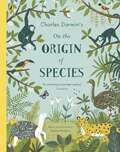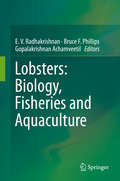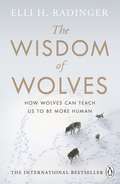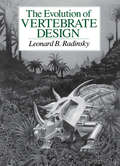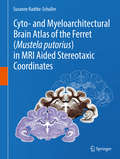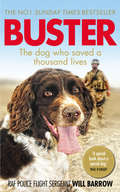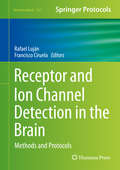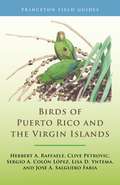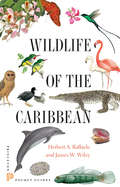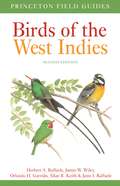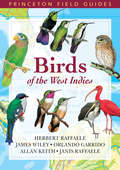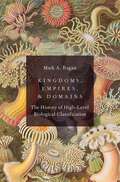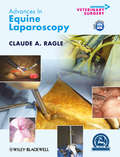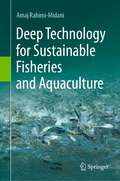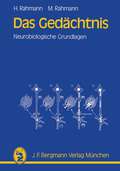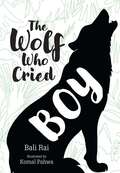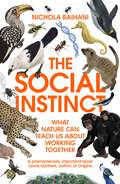- Table View
- List View
On The Origin of Species: Or The Preservation Of Favoured Races In The Struggle For Life
by Sabina RadevaThe first ever picture-book retelling of Charles Darwin's On The Origin of Species; this accessible work brings evolution to the younger generation through stylish illustrations and a simple, easy-to-understand text.On The Origin of Species has been the definitive explanation of the theory of evolution since it was first published in 1859. Now molecular biologist and illustrator Sabina Radeva unites her two passions to create a 48-page retelling of this seminal text.Pulling together Darwin's observations from his travels around the world and his groundbreaking - and controversial - explanation of how species form, develop and change over hundreds of thousands of years, On The Origin of Species is as relevant and important now as it ever was.
Lobsters: Biology, Fisheries and Aquaculture
by E. V. Radhakrishnan Bruce F. Phillips Gopalakrishnan AchamveetilThis book is an important addition to the knowledge of lobster research. The book complements other books published on lobster research and management as it focuses on Indian lobster fisheries and aquaculture developments where there have been nearly 350 research papers and reports and 19 PhD awards. The book has 15 chapters written by international experts covering many aspects of the biology of a number of spiny and slipper lobster species occurring in India and world oceans with maps illustrating global distribution of spiny lobster families, genera and species. An updated taxonomy and checklist of marine lobsters, the status and management of lobster fisheries in India and Indian Ocean Rim countries and a review of aquaculture research in India and other major countries have also been presented. The book is timely as the 2nd International Indian Ocean Expedition (IIOE) is currently underway (2015-2020), 50 years after the original IIOE (1959-1965), with some of the original lobster research on the biology and distribution of phyllosoma larvae being undertaken on the plankton samples collected during the first IIOE. Many of the chapters are contributed by the authors from Central Marine Fisheries Research Institute (CMFRI), which has been collecting fishery and biological data on lobsters since 1950 when lobster fishing began on a subsistence scale, followed by some industrial fishing for lobsters in different parts of India. Unfortunately, the development of some of these lobster fisheries was followed by overfishing due to lack of enforcement of regulations. The book provides a valuable addition to our knowledge of the biology, fisheries and aquaculture of spiny and slipper lobsters.
The Wisdom of Wolves: Understand How Wolves Can Teach Us To Be More Human
by Elli H. Radinger'Enchanting' Mail on Sunday They care for their elderly, play with their kids, and always put family first. Can we all learn something from the wisdom of wolves? In this unforgettable book, wolf expert and naturalist Elli Radinger draws on her 25 years of first-hand experience among the wolves of Yellowstone National Park to tell us their remarkable stories.__________Wolves aren't wolfish. They can die of broken hearts, show tenderness to their young and elderly, and their packs are led by couples, with the key decisions made by females. They play, they pretend and they predate. They are more complex than we ever knew and more like us than we ever imagined. You'll meet Oh-Six, the she-wolf whose bold hunting technique astounded the most experienced biologists, Casanova who succeeded in luring his love away from her pack, and Druid alpha male 21, the magnanimous and compassionate leader.Ultimately, Radinger shows how much we can learn from these beautiful and mysterious creatures, and how much there is to gain from emulating the wisdom of wolves.'This book is the result of her two decades of close observation; part impassioned memoir, part natural history study, and part photo gallery. Her access to her subjects is extraordinary' Sunday Times
Evolution of Vertebrate Design
by Leonard B. RadinskyThe Evolution of Vertebrate Design is a solid introduction to vertebrate evolution, paleontology, vertebrate biology, and functional, comparative anatomy. Its lucid style also makes it ideal for general readers intrigued by fossil history. Clearly drawn diagrams illustrate biomechanical explanations of the evolution of fins, jaws, joints, and body shapes among vertebrates. A glossary of terms is included. "A luminous text is matched by lucid drawings rationally placed. . . . A great teaching monograph, the book will charm lay readers of fossil history. For virtually every college & public collection."—Scitech Book News
Evolution of Vertebrate Design
by Leonard B. RadinskyThe Evolution of Vertebrate Design is a solid introduction to vertebrate evolution, paleontology, vertebrate biology, and functional, comparative anatomy. Its lucid style also makes it ideal for general readers intrigued by fossil history. Clearly drawn diagrams illustrate biomechanical explanations of the evolution of fins, jaws, joints, and body shapes among vertebrates. A glossary of terms is included. "A luminous text is matched by lucid drawings rationally placed. . . . A great teaching monograph, the book will charm lay readers of fossil history. For virtually every college & public collection."—Scitech Book News
Evolution of Vertebrate Design
by Leonard B. RadinskyThe Evolution of Vertebrate Design is a solid introduction to vertebrate evolution, paleontology, vertebrate biology, and functional, comparative anatomy. Its lucid style also makes it ideal for general readers intrigued by fossil history. Clearly drawn diagrams illustrate biomechanical explanations of the evolution of fins, jaws, joints, and body shapes among vertebrates. A glossary of terms is included. "A luminous text is matched by lucid drawings rationally placed. . . . A great teaching monograph, the book will charm lay readers of fossil history. For virtually every college & public collection."—Scitech Book News
Evolution of Vertebrate Design
by Leonard B. RadinskyThe Evolution of Vertebrate Design is a solid introduction to vertebrate evolution, paleontology, vertebrate biology, and functional, comparative anatomy. Its lucid style also makes it ideal for general readers intrigued by fossil history. Clearly drawn diagrams illustrate biomechanical explanations of the evolution of fins, jaws, joints, and body shapes among vertebrates. A glossary of terms is included. "A luminous text is matched by lucid drawings rationally placed. . . . A great teaching monograph, the book will charm lay readers of fossil history. For virtually every college & public collection."—Scitech Book News
Cyto- and Myeloarchitectural Brain Atlas of the Ferret (Mustela putorius) in MRI Aided Stereotaxic Coordinates
by Susanne Radtke-SchullerDescriptionThis stereotaxic atlas of the ferret brain provides detailed architectonic subdivisions of the cortical and subcortical areas in the ferret brain using high-quality histological material stained for cells and myelin together with in vivo magnetic resonance (MR) images of the same animal. The skull-related position of the ferret brain was established according to in vivo MRI and additional CT measurements of the skull. Functional denotations from published physiology and connectivity studies are mapped onto the atlas sections and onto the brain surface, together with the architectonic subdivisions. High-resolution MR images are provided at levels of the corresponding histology atlas plates with labels of the respective brain structures. The book is the first atlas of the ferret brain and the most detailed brain atlas of a carnivore available to date. It provides a common reference base to collect and compare data from any kind of research in the ferret brain.Key Features Provides the first ferret brain atlas with detailed delineations of cortical and subcortical areas in frontal plane. Provides the most detailed brain atlas of a carnivore to date. Presents a stereotaxic atlas coordinate system derived from high-quality histological material and in vivo magnetic resonance (MR) images of the same animal. Covers the ferret brain from forebrain to spinal cord at intervals of 0.6 mm on 58 anterior-posterior levels with 5 plates each. Presents cell (Nissl) stained frontal sections (plate 1) and myelin stained sections (plate 2) in a stereotaxic frame. Provides detailed delineations of brain structures and their denomination on a Nissl stained background on a separate plate (3). Compiles abbreviations on plate 4, a plate that also displays the low resolution MRI of the atlas brain with the outlines of the Nissl sections in overlay. Displays high-resolution MR images at intervals of 0.15 mm from another animal with labeled brain structures as plate 5 corresponding to the anterior-posterior level of each atlas plate. Provides detailed references used for delineation of brain areas. Target audience of the book: The book addresses researchers and students in neurosciences who are interested in brain anatomy in general (e.g., for translational purposes/comparative aspects), particularly those who study the ferret as important animal model of growing interest in neurosciences.
Buster: The dog who saved a thousand lives
by RAF Police Sergeant Will Barrow Isabel GeorgeThe Sunday Times Top Ten BestsellerThousands of lives have been saved by this spaniel. He is a best friend in dog’s clothing. An RAF dog with his mossy feet firmly on the ground. A brave dog who has served his colleagues and his country with unstinting devotion. A dog in a million.This is the story of the partnership of Buster and Will, told by Will himself, describing how each came to save the other’s life. This is a relationship that produced some heroic feats in the dust and desert heat of Afghanistan - and beyond. Buster, uniquely, has served five tours of duty - more than any other military dog. “With some dogs you share a boil in the bag breakfast and maybe a blanket on a cold desert floor. Some you wouldn’t leave in charge of your Grandma unless you wanted to find out just how fast the old girl could run. But, if you’re very, very lucky there will be the one dog you would lay down your life for – and for me that dog is Buster.”As told to Isabel George.
Receptor and Ion Channel Detection in the Brain: Methods and Protocols (Neuromethods #110)
by Rafael Luján and Francisco CiruelaReceptor and Ion Channel Detection in the Brain provides state-of-the-art and up-to-date methodological information on molecular, neuroanatomical and functional techniques that are currently used to study neurotransmitter receptors and ion channels in the brain. The chapters have been contributed by world-wide recognized neuroscientists who explain in an easy and detailed way well established and tested protocols embracing molecular, cellular, subcellular, anatomical and electrophysiological aspects of the brain. This comprehensive and practical manual is presented in a simple, step-by-step manner for laboratory use, and also offers unambiguous detail and key implementation advice that proves essential for successful results and facilitate choosing the best method for the target proteins under study. This work serves as a useful guide for young researchers and students in training as well as for neurologists and established scientists who wish to extend their repertoire of techniques.
Birds of Puerto Rico and the Virgin Islands: Fully Revised and Updated Third Edition (Princeton Field Guides #153)
by Birds of the Wes Herbert A. Raffaele Clive Petrovic Sergio A. López Lisa D. Yntema José A. FariaThe only fully illustrated guide to feature all the bird species of Puerto Rico and the Virgin IslandsThis portable and informative field guide describes the bird species found on Puerto Rico and the Virgin Islands. Fully updated, the guide presents all 347 species, both naturally occurring as well as introduced, and highlights 19 endemic species found nowhere else in the world. Species are sorted by habitat to facilitate identification and extra illustrations are provided for birds similar in appearance.The only fully illustrated guide to feature all 347 bird species in Puerto Rico and the Virgin IslandsSpecies sorted by habitat for easier identificationText and illustrations on facing pages for ease of identificationExtensive introduction covering taxonomy, migration, biogeography, and conservationUseful information on birding hotspots throughout the region
Wildlife of the Caribbean
by Birds of the Wes Herbert A. Raffaele James WileyThe essential guide to the living wonders of the Caribbean islandsThis is the first comprehensive illustrated guide to the natural world of the Caribbean islands. It contains 600 vivid color images featuring 451 species of plants, birds, mammals, fish, seashells, and much more. While the guide primarily looks at the most conspicuous and widespread species among the islands, it also includes rarely seen creatures—such as the Rhinoceros Iguana and Cuban Solenodon—giving readers a special sense of the region's diverse wildlife.Each species is represented by one or more color photos or illustrations; details regarding its identification, status, and distribution; and interesting aspects of its life history or relationship to humans. In addition, an introductory section focuses on the unique characteristics of the Caribbean’s fauna and flora, the threats faced by both, and some of the steps being taken to sustain the area’s extraordinary natural heritage.Wildlife of the Caribbean is the essential field guide for learning about the living wonders in this area of the world.The only guide of its kind for the Caribbean islands600 detailed color images feature 451 amazing speciesStraightforward descriptions suitable for general audienceCompact size makes the guide easy to carry
Birds of the West Indies Second Edition (Princeton Field Guides #143)
by Birds of the Wes Herbert A. Raffaele James Wiley Orlando H. Garrido Allan Keith Janis I. RaffaeleAn updated edition of the acclaimed field guide to the spectacular birds of the West IndiesBirds of the West Indies is the first field guide that covers and depicts all birds known to occur in the region, including infrequently occurring and introduced forms. Now fully updated and expanded, this stunningly illustrated book features detailed accounts of more than 600 species, describing identification field marks, range, status, voice, and habitat. There are more than 100 beautiful color plates that depict plumages of all species—including those believed to have recently become extinct—as well as distribution maps, a color code for endemic birds, and an incisive introduction that discusses avifaunal changes in the West Indies in the past fifteen years and the importance of conservation.Covers more than 60 new species, including vagrants, introductions, and taxonomic splitsUpdates the status of every speciesFeatures illustrations for all new species and improved artwork for warblers and flycatchersColor codes endemic species confined to one or just a few islandsIncludes many new and enhanced mapsProvides bird weights for each speciesCompact and easy to use in the field
Wildlife of the Caribbean
by Herbert A. Raffaele James WileyThis is the first comprehensive illustrated guide to the natural world of the Caribbean islands. It contains 600 vivid color images featuring 451 species of plants, birds, mammals, fish, seashells, and much more. While the guide primarily looks at the most conspicuous and widespread species among the islands, it also includes rarely seen creatures—such as the Rhinoceros Iguana and Cuban Solenodon—giving readers a special sense of the region's diverse wildlife.Each species is represented by one or more color photos or illustrations; details regarding its identification, status, and distribution; and interesting aspects of its life history or relationship to humans. In addition, an introductory section focuses on the unique characteristics of the Caribbean’s fauna and flora, the threats faced by both, and some of the steps being taken to sustain the area’s extraordinary natural heritage.Wildlife of the Caribbean is the essential field guide for learning about the living wonders in this area of the world.The only guide of its kind for the Caribbean islands600 detailed color images feature 451 amazing speciesStraightforward descriptions suitable for general audienceCompact size makes the guide easy to carry
Birds of the West Indies
by Herbert A. Raffaele James Wiley Orlando H. Garrido Allan Keith Janis I. Raffaele Tracy Pedersen Kristin WilliamsFully illustrated, easy to use, and completely up-to-date, Birds of the West Indies is the only field guide that covers all of the bird species known to occur in the region--including migrants and infrequently occurring forms. Each species is represented by a full description that includes identification field marks, status and range, habitat, and voice. A map showing the bird's distribution accompanies many species accounts, and plumages of all species are depicted in ninety-three beautifully rendered color plates. Bird lovers, vacationing tourists, local residents, and "armchair travelers" will all want to own this definitive field guide to the birds of the West Indies. Includes all species recorded in the region Features ninety-three color plates with concise text on facing pages for quick reference and easy identification Species accounts cover identification, voice, status and habitat, and range Color distribution maps
Birds of the West Indies (PDF)
by Herbert A. Raffaele James Wiley Orlando H. Garrido Allan Keith Janis I. Raffaele Tracy Pedersen Kristin WilliamsFully illustrated, easy to use, and completely up-to-date, Birds of the West Indies is the only field guide that covers all of the bird species known to occur in the region--including migrants and infrequently occurring forms. Each species is represented by a full description that includes identification field marks, status and range, habitat, and voice. A map showing the bird's distribution accompanies many species accounts, and plumages of all species are depicted in ninety-three beautifully rendered color plates. Bird lovers, vacationing tourists, local residents, and "armchair travelers" will all want to own this definitive field guide to the birds of the West Indies. Includes all species recorded in the region Features ninety-three color plates with concise text on facing pages for quick reference and easy identification Species accounts cover identification, voice, status and habitat, and range Color distribution maps
Mechanisms of Lymphocyte Activation and Immune Regulation VII: Molecular Determinants of Microbial Immunity (Advances in Experimental Medicine and Biology #452)
by RafiAhmed AlanSher SudhirGuptaProceedings of the Seventh International Conference held in New Port Beach, California, February 6-8, 1998
Kingdoms, Empires, and Domains: The History of High-Level Biological Classification
by Mark A. RaganA generation or two before Socrates, thinkers classified the world's organisms into three categories: plants, animals, and man. However, Aristotle recognized that some organisms, such as sponges and sea-fans, share properties of both plants and animals. These became known as zoophytes. Since then, scientists have explored the idea of a "third kingdom." In Kingdoms, Empires, and Domains, leading molecular systematist Mark A. Ragan offers a history of the idea that there is more to the living world than plants and animals. Progressing chronologically through philosophical, religious, literary, and other pre-scientific traditions, Ragan traces how transgressive creatures such as sponges, corals, algae, fungi, and diverse microscopic beings have been described, categorized, and understood throughout history. The book considers their appearance in early Christian, Islamic, and Jewish traditions; myths, legends, and traveller's tales; occult literature; and more. Kingdoms, Empires, and Domains also details how the concept of a "third kingdom" has evolved throughout the history of scientific botany and zoology, and continues to evolve up to the present day. Kingdoms, Empires, and Domains features original translations of passages from key historical texts, many of which have never appeared in English before. It also draws on the most recent and reliable scientific literature. A sweeping, interdisciplinary study, Kingdoms, Empires, and Domains is essential reading for students and scholars of the history of biological classification and anyone interested in the history of ideas about the natural world.
Kingdoms, Empires, and Domains: The History of High-Level Biological Classification
by Mark A. RaganA generation or two before Socrates, thinkers classified the world's organisms into three categories: plants, animals, and man. However, Aristotle recognized that some organisms, such as sponges and sea-fans, share properties of both plants and animals. These became known as zoophytes. Since then, scientists have explored the idea of a "third kingdom." In Kingdoms, Empires, and Domains, leading molecular systematist Mark A. Ragan offers a history of the idea that there is more to the living world than plants and animals. Progressing chronologically through philosophical, religious, literary, and other pre-scientific traditions, Ragan traces how transgressive creatures such as sponges, corals, algae, fungi, and diverse microscopic beings have been described, categorized, and understood throughout history. The book considers their appearance in early Christian, Islamic, and Jewish traditions; myths, legends, and traveller's tales; occult literature; and more. Kingdoms, Empires, and Domains also details how the concept of a "third kingdom" has evolved throughout the history of scientific botany and zoology, and continues to evolve up to the present day. Kingdoms, Empires, and Domains features original translations of passages from key historical texts, many of which have never appeared in English before. It also draws on the most recent and reliable scientific literature. A sweeping, interdisciplinary study, Kingdoms, Empires, and Domains is essential reading for students and scholars of the history of biological classification and anyone interested in the history of ideas about the natural world.
Advances in Equine Laparoscopy (AVS Advances in Veterinary Surgery #3)
by Claude RaglePart of the Advances in Veterinary Surgery series copublished with the ACVS Foundation and Wiley-Blackwell, Advances in Equine Laparoscopy presents a state-of-the-art reference on laparoscopic skills and procedures in the horse. Chapters are written by the leading experts in the field, and each section includes a practical review of the published literature. Encompassing instrumentation, basic principles, and specific techniques, Advances in Equine Laparoscopy offers an up-to-date, reliable resource for comprehensive information about equine laparoscopy. This current, well-referenced text begins with a section on the fundamentals of laparoscopy, then moves into sections on the clinical application of laparoscopic techniques in the standing or recumbent horse. A companion website offers eight video clips demonstrating selected procedures at www.wiley.com/go/ragle. Advances in Equine Laparoscopy is an invaluable guide for equine surgical specialists and equine clinicians interested in laparoscopic techniques.
Advances in Equine Laparoscopy (AVS Advances in Veterinary Surgery)
by Claude A. RaglePart of the Advances in Veterinary Surgery series copublished with the ACVS Foundation and Wiley-Blackwell, Advances in Equine Laparoscopy presents a state-of-the-art reference on laparoscopic skills and procedures in the horse. Chapters are written by the leading experts in the field, and each section includes a practical review of the published literature. Encompassing instrumentation, basic principles, and specific techniques, Advances in Equine Laparoscopy offers an up-to-date, reliable resource for comprehensive information about equine laparoscopy. This current, well-referenced text begins with a section on the fundamentals of laparoscopy, then moves into sections on the clinical application of laparoscopic techniques in the standing or recumbent horse. A companion website offers eight video clips demonstrating selected procedures at www.wiley.com/go/ragle. Advances in Equine Laparoscopy is an invaluable guide for equine surgical specialists and equine clinicians interested in laparoscopic techniques.
Deep Technology for Sustainable Fisheries and Aquaculture
by Amaj Rahimi-MidaniThis book uses real-world examples from the aquaculture industry to demonstrate how deep technology is assisting farmers and vulnerable communities. Works conducted by Poseidon-AI (a deep tech company involved in the aquaculture sector) in different countries are presented as case studies to show the positive impacts of deep tech involvement in the aquaculture sector. Primary industries, such as fisheries and aquaculture, rely heavily on labor. Furthermore, the manual practices of these farming methods increase material waste and reduce yields, resulting in higher costs and lower revenues. Poikilotherms make up the majority of aquatic animals, and environmental changes have a significant impact on them. This means that, due to climate change, farming of these animals cannot continue in the same way that it has for centuries. Artificial intelligence, machine learning, image processing, sensing, and automation are approaches that can assist these farms in dealing with rapid environmental changes while also assisting farmers in growing their businesses sustainably. This book is of interest to climate change scientists, entrepreneurs, investors, civil workers, and policymakers. Furthermore, the book is a great complimentary material for graduate students of fisheries, aquaculture, ecology, soil science, water management and environmental sciences. All national and international policymakers working in implementation of UNSDGs and sustainability, will find this book a useful read.
Das Gedächtnis: Neurobiologische Grundlagen
by Hinrich Rahmann Mathilde RahmannDie Erforschung des Gedächtnisses rückt in immer stärkerem Maß in das Zentrum des allgemeinen Interesses unserer Gesellschaft. Ziel dieses Buches ist es, über die bisher von den verschiedensten Disziplinen der Neurobiologie erarbeiteten Grundlagen der Gedächtnisforschung in einem überschaubaren Umfang und allgemein verständlich zu informieren. Das Buch setzt keine spezifischen Kenntnisse voraus. Neu eingeführte wissenschaftliche Begriffe werden jeweils erläutert. Ausgehend von den Erkenntnissen der vergleichenden Anatomie, Histologie, Cytologie sowie den wichtigsten Grundlagen der Neurophysiologie, Neurochemie und der Verhaltensforschung werden einige derzeit häufiger diskutierte Gedächtnishypothesen referiert. Das Funktionsmodell einer Gedächtnisbildung wird durch molekulare Bahnung in den Synapsen erläutert. Dabei spielen die funktionsmorphologische Plastizität der Nervenendigungen sowie die Anpassungsfähigkeit von wichtigen Stoffwechselvorgängen der Synapse eine große Rolle.
The Social Instinct: How Cooperation Shaped the World
by Nichola RaihaniWhy cooperate? This may be the most important scientific question we have ever, and will ever, face. The science of cooperation tells us not only how we got here, but also where we might end up. Cooperation explains how strands of DNA gave rise to modern-day nation states. It defines our extraordinary ecological success as well as many of the most surprising features of what make us human: not only why we live in families, why we have grandmothers and why women experience the menopause, but also why we become paranoid and jealous, and why we cheat. Nichola Raihani also introduces us to other species who, like us, live and work together. From the pied babblers of the Kalahari to the cleaner fish of the Great Barrier Reef, they happen to be some of the most fascinating and extraordinarily successful species on this planet. What do we have in common with these other species, and what is it that sets us apart?Written at a time of global pandemic, when the challenges and importance of cooperation have never been greater, The Social Instinct is an exhilarating, far-reaching and thought-provoking journey through all life on Earth, with profound insights into what makes us human and how our societies work.
